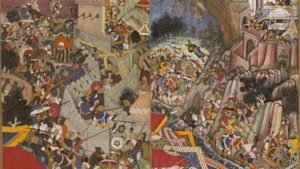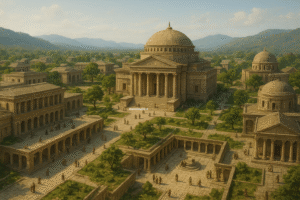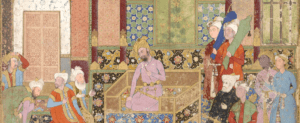The period between the 7th and 10th centuries CE witnessed the rise of dynamic maritime trade networks in the Indian Ocean. During this time, South Indian dynasties like the Cholas and Rashtrakutas played a pivotal role in facilitating and expanding trade with regions as far as Southeast Asia, China, and the Middle East. These maritime networks not only brought immense wealth to their kingdoms but also enabled significant cultural and technological exchanges, shaping the historical trajectory of the Indian Ocean world.
This article explores the contributions of the Chola and Rashtrakuta dynasties to maritime trade and their impact on regional and global interactions during this period.
The Importance of Indian Ocean Trade
The Indian Ocean had long been a hub for maritime trade, connecting the Indian subcontinent to East Africa, the Arabian Peninsula, and Southeast Asia. By the 7th century CE, trade routes across the ocean were thriving due to advancements in navigation, shipbuilding, and the seasonal use of monsoon winds.
Indian merchants exported textiles, spices, precious gems, and ivory, while importing luxury goods such as Chinese silk, Arabian horses, and Persian ceramics. These trade networks also facilitated the movement of ideas, religions, and technologies, fostering cultural exchange on an unprecedented scale.
The Rashtrakutas and Maritime Trade
The Rashtrakutas (8th–10th centuries CE) emerged as one of the dominant powers in the Deccan, ruling from their capital at Manyakheta (modern-day Karnataka). Known for their military prowess and cultural patronage, the Rashtrakutas were also deeply involved in maritime trade.
Rashtrakuta ports along the western coast of India, such as Sopara, Bharuch, and Chaul, became thriving centers of trade. These ports connected the empire to the Persian Gulf, East Africa, and Southeast Asia, acting as gateways for goods and cultural exchanges.
The Rashtrakutas maintained strong diplomatic and trade relationships with the Abbasid Caliphate in Baghdad. Records suggest that Indian merchants played a key role in supplying luxury goods to the Islamic world, while Rashtrakuta rulers benefited from the wealth generated by these interactions.
Through maritime trade, the Rashtrakutas facilitated the spread of Indian religions, particularly Hinduism and Buddhism, to Southeast Asia. Their participation in the Indian Ocean network contributed to the creation of a shared cultural heritage across the region.

The Cholas and Their Maritime Dominance
The Chola dynasty (9th–13th centuries CE) rose to prominence in Tamil Nadu, establishing one of the most extensive and powerful empires in South Indian history. Under rulers like Raja Raja Chola I and Rajendra Chola I, the Cholas transformed into a maritime superpower, asserting control over key trade routes in the Indian Ocean.
The Cholas are renowned for their formidable navy, which they used to project power and secure trade interests. In the early 11th century, Rajendra Chola I launched a naval expedition against the Srivijaya Empire in Southeast Asia, targeting key ports like Sumatra, Malay Peninsula, and Java. This campaign ensured the Cholas’ dominance over lucrative trade routes.
The Cholas established vibrant trade hubs along the Coromandel Coast, including Nagapattinam and Kaveripattinam. These ports facilitated the export of textiles, spices, and pearls, which were in high demand across Southeast Asia, China, and the Middle East.
The Cholas’ maritime dominance also led to the spread of Indian cultural and religious traditions in Southeast Asia. Temples, inscriptions, and architectural influences in regions like Cambodia, Vietnam, and Indonesia bear testimony to the Chola impact on the region.

Technological Advancements in Maritime Trade
Both the Rashtrakutas and Cholas contributed to advancements in shipbuilding, developing large ocean-going vessels capable of carrying substantial cargo over long distances. These ships were equipped with lateen sails, which improved navigation and maneuverability.
Indian mariners had an intimate knowledge of monsoon patterns, enabling them to time their voyages efficiently. This understanding was crucial for facilitating regular trade across vast oceanic distances.
The Impact of Maritime Trade
Maritime trade brought immense wealth to both the Rashtrakuta and Chola empires. The revenue generated from trade was used to fund ambitious infrastructure projects, including temple construction, irrigation systems, and urban development.
The Indian Ocean trade network became a melting pot of cultures, with Indian merchants and travelers interacting with counterparts from Arabia, Persia, and Southeast Asia. These exchanges enriched the cultural and intellectual life of the Indian subcontinent.
Hinduism and Buddhism were carried across the Indian Ocean to Southeast Asia, where they deeply influenced local cultures and political systems. The Cholas, in particular, played a key role in promoting Shaivism and Vaishnavism abroad.
Decline and Legacy
By the late 12th century, the decline of the Rashtrakutas and the weakening of the Cholas’ naval power led to the rise of new maritime players, including the Islamic sultanates and later the Portuguese. Despite these changes, the foundations laid by the Rashtrakutas and Cholas continued to influence regional trade and cultural exchanges.
The maritime achievements of the Rashtrakutas and Cholas left a lasting legacy on Indian Ocean history. Their role in expanding trade networks and fostering cross-cultural interactions contributed to the growth of a vibrant and interconnected Indian Ocean world.
The Rashtrakutas and Cholas were instrumental in shaping the maritime history of the Indian Ocean. Through their trade networks, naval power, and cultural exchanges, these dynasties not only brought prosperity to their realms but also strengthened India’s connections with the wider world. Their achievements underscore the central role of maritime trade in the economic and cultural dynamism of early medieval India.






